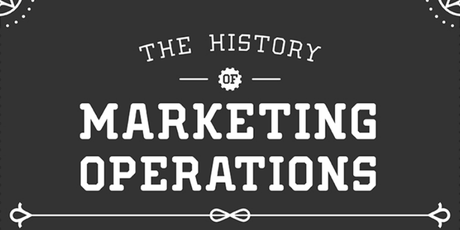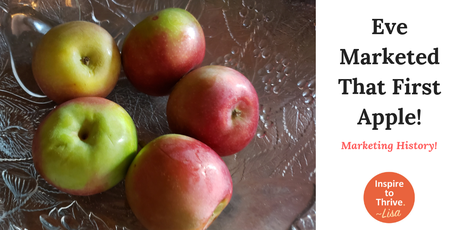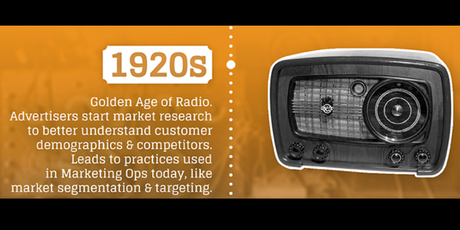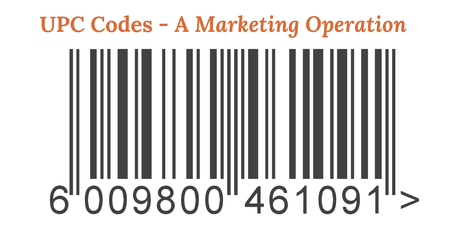Marketing Operations - What Exactly IS Marketing?
Marketing operations have existed for a long time. Believe it or not, some form of marketing has been around since the beginning of time. Today's textbook definition is defined as:
Marketing, an activity, set of institutions, and processes for creating, communicating, delivering, and exchanging offerings that have value for customers.
More simply stated: Marketing is the activity of satisfying a person's needs and wants.
It all began with The Apple 🍎.
The History of Marketing Operations
To explain the History of Marketing you must go back to the beginning of time. First, Eve had an apple, a very special apple. She wanted to eat the apple. Eve needed to convince Adam to eat the apple.

She didn't know it then, but Eve was using her marketing skills to convince Adam to eat the apple. Then she outlined her plan and made her pitch. Finally, Eve made Adam realize that he did need to eat the apple. We all know, Eve's marketing plan worked. Thus, you could say, Eve became the first marketing person.
So long as people need or want something, there will always be someone or something out there to fulfill those needs and wants. Many times, people do not know that they need or want something until someone points it out to them. As a result, marketing comes into play.
The Evolution of Marketing Trends
Sales and Marketing go hand-in-hand. They have always been handcuffed together. How does a sales person market their goods? That's been the ago old question.
Companies started working towards an answer to that question forever. But it wasn't until the 1920's that companies thought seriously about a solution to that question.
1920's The Golden Age of Radio
First, radio was the force in marketing communication. It was a way to speak directly to the consumer. Marketing was promoted through talking about products. After all, there was no option for visual contact at that time.

Companies would hire spokespersons to tell their story. Oftentimes, jingles would be created to promote brand recognition. It was a simplistic form of marketing.
It's interesting to note that, back then, it costs $100 for a 10-minute spot on the radio. 1930's P&G Branding
By 1930, it became evident that name recognition was extremely important. Companies wanted their brand to become a "household name". The first company to pioneer this mindset was Proctor & Gamble. They were founded back in 1837.
James Gamble invented the first bar of soap. Harley Proctor was the first Advertising and Sales Manager. He named it Ivory Soap. His name came first because of his marketing expertise.
Together, from the 30's to present day, P&G has been the leader in marketing strategy. They launched such famous brands as Tide in 1946. Crest in 1955. JIF Peanut Butter in 1956. Other brands included: Pampers, Folgers, and Pringles in the 60's.
For this reason, P&G has 83 brands now. They raked in $1 Billion last year. P&G surely has created a successful marketing trend.
1960's Marketing Science
By the 60's, it became apparent that this was the time to include the consumer in their marketing strategies. Hence, Marketing Science Institutes (MSI) were introduced to marketing operations. Unbiased consumer product testing institutes became popular.
These institutes would create surveys sponsored by product companies. They were searching for feedback on their product brand. Next, they would compare them to their competitors.
Many institutes would mail out boxes of samples of their product line. Finally, they would include their questionnaire to households throughout the country. P&G was a major supporter of this marketing concept.
Good Housekeeping gave products their "seal of approval" based on the results of these surveys. Their seal logo was a strong marketing benefit in a company's marketing plan.
1970's Profiling Customers
The concept of profiling the consumer came to the forefront of marketing operations during this decade. The profiling was to analyze their needs and wants.
Companies became concerned about reaching the right target market. Does their product meet their customers' needs? Is their product something the consumer wants? Who is the company's ideal customer?
Market researchers and consumer panels were created to conduct in-depth research of the ideal customer. The panels focused on reaching certain market segments in order to sell specific products. They were looking for patterns and demographics. These included preference, socioeconomic status, lifestyle, product use, etc.
1980's Metrics Statistics - POS Technology Soars
With all this new data, it was important to educate the marketing industry. They had to learn how to utilize the new statistical analysis information. Therefore, marketing textbooks added chapters on metrics, marketing organization structure and return on investment. This was the beginning of a new age in modern day market planning.
At the same time marketing technology was growing rapidly almost daily. It began with the Computer Identics Corporation (CIC). They installed the first true barcode system at General Motors.
UPC Codes Became Part of Marketing Operations
Later, the National Association of Food Chains developed, for the food industry's purposes, a Universal Product Code (UPC). Food coupons were the first step in tracking consumer product purchases for marketing purposes. Hence, this was a major catalyst in changing marketing strategy.

Notably, a pack of Wrigley's chewing gum was the first retail product ever sold using a barcode scanner. By 1984, 33% of all grocery stores used barcodes. Today, almost 100% of retail stores, along with several other types of businesses, use barcodes.
1990's Customer Retention
By this time, with all the statistical data and technology, comes the world of fierce competition for market share. With all this information available to marketing agencies, companies now have higher expectations. They are raising the bar to make their marketing departments accountable and responsible for market research and for their ROI.
Customer retention became the next point of focus for marketing operations. Companies wanted to emphasize the importance of customer loyalty and how critical it is to have that competitive edge. Thus, marketing automation software helped to assist marketing departments and agencies with their strategic marketing research.

Early 2000's The Digital Age
The turn of the 21st Century produced the Digital Age which created a new Marketing Mission, namely, "To propose the concept of adding more processing of Metrics Technology to marketing procedures."
Not to mention, Search Engine Marketing provided more options for the new millennium. Then, new advertising channels were created, along with personalized message directories. The likes of which were introduced as follows:
- 2003 Google, already the strongest player in the market since 1998, released ADWORDS.
- 2004 Facebook is born, as the first player in the Mobile Revolution.
- 2005 YouTube is born as a popular video media source.
Analyst firm, International Data Corporation, notices a rise in Market Operations.
Gary Katz publishes article on Market Operations.
Market Operations Symposium is held in Los Angeles.
Social Media Becomes Part of Marketing Operations
- 2006 Twitter takes the world by storm as the next member of the Mobile Revolution.
Marketing Operations holds round table before a crowd in Silicon Valley.
Finally, Marketing Operations Partners establish first marketing operations consultancy. - 2007 Formal framework for defining marketing operations began.
1st benchmark study on marketing operations establish best practices. - 2008 1st formal marketing operations training course started.
1st University for marketing operations has begun. - 2011 Twitter introduces "Tweets and Trends".
Facebook's Ad Revenue hits $1.8 Billion.
Marketing operations is identified as the fastest profession in marketing. More Updated Marketing Operations
* 2013 Programmable Media Buying becomes available.
The introduction of software providing real-time bidding platforms. Hence, these increased speed and efficiency to online advertising.
Introduction of Custom Marketing software to help companies with their marketing efforts. And then of course, automated marketing became the norm.
* 2014 Summit meeting on Marketing Operations and Technology took place.
* 2015 Global Digital ad spending reaches $171 Billion. $58.6 Billion in the US alone. More About Marketing Operations
- Learn about what their teams do.
- Learn the misconceptions surrounding the field @BIT.LY/MARKETINGOPSMYTHS.
For additional information, see the Infographic below or visit www.wrike.com
Meanwhile, new computer technology was growing by leaps and bounds. Therefore, it's time to include the statistical research in all your marketing strategy!
This Infographic below is brought to you by Wrike project management software.

Lastly, I'd love to know in the comments below what facts you found most interesting from this marketing operations history lesson?
How can you apply some of these into your marketing today? Let's discuss it in the comments!


